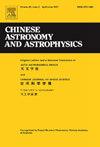Lyman-alpha太阳望远镜机载抖动模式及平场标定结果
Q4 Physics and Astronomy
引用次数: 0
摘要
采用数字探测器的太阳望远镜获得的图像在用于科学研究之前,必须进行平场校正,这反映了光学元件传输效率和探测器像元响应的不均匀性。这意味着平场校正是获取高水平科学数据的必要步骤。莱曼-阿尔法太阳望远镜(Lyman-alpha Solar Telescope, LST)是“Kuafu-1”(先进天基太阳天文台:ASO-S,中国名称Kuafu-1)任务的三个有效载荷之一,由三个科学仪器组成:双波段日冕成像仪(SCI)和两个全圆盘太阳望远镜,分别命名为白光太阳望远镜(WST)和太阳圆盘成像仪(SDI)。WST和SDI采用互补金属氧化物半导体(CMOS)作为图像传感器,其平场的主要特征是激光退火后形成的条纹结构。在紫外波段使用时,CMOS传感器会受到一定的降解和辐射损伤,以及水汽凝结和有机物积累的污染,对获得的平场有一定的影响。本文主要介绍了自2022年10月9日ASO-S任务发射以来,WST和SDI在飞行平场校准中使用的抖动模式及其优化,计算的平场图像及其在此期间的演变。我们还简要介绍了WST和SDI中探测器随时间的退化和辐射损伤。本文章由计算机程序翻译,如有差异,请以英文原文为准。
Dither Pattern and Results of Inflight Flat-field Calibration of the Lyman-alpha Solar Telescope onboard ASO-S Mission
Before being used for scientific research, images obtained by solar telescopes with digital detectors must be corrected for flat-field, which reflects the non-uniformity coming from the non-uniform transmission efficiency of optical components and response of detector pixels. That means flat-field correction is a necessary step in the pipe-line of high-level scientific data. As one of the three payloads of the Kuafu-1 (Advanced Space-based Solar Observatory: ASO-S, Chinese name Kuafu-1) mission, the Lyman-alpha Solar Telescope (LST) consists of three scientific instruments: including a dual-waveband Solar Corona Imager (SCI), and two full-disk solar telescopes which are named the White-light Solar Telescope (WST) and the Solar Disk Imager (SDI). The WST and the SDI use Complementary Metal-Oxide-Semiconductor (CMOS) as image sensors, and the main feature of the flat field is the stripe structure which is caused by laser annealing. When used in the ultraviolet wavelengths, CMOS sensors will be subject to certain degradation and radiation damage, as well as the pollution of water vapor condensation and organic matter accumulation, which will have some influence on the obtained flat field. This paper mainly presents the dither pattern and its optimization used by the WST and the SDI in the in-flight flat field calibration since the launch of the ASO-S mission on 2022 October 9, the computed flat field images and their evolution during the period. We also briefly present the degradation and the radiation damage of the detectors in the WST and the SDI over time.
求助全文
通过发布文献求助,成功后即可免费获取论文全文。
去求助
来源期刊

Chinese Astronomy and Astrophysics
Physics and Astronomy-Astronomy and Astrophysics
CiteScore
0.70
自引率
0.00%
发文量
20
期刊介绍:
The vigorous growth of astronomical and astrophysical science in China led to an increase in papers on astrophysics which Acta Astronomica Sinica could no longer absorb. Translations of papers from two new journals the Chinese Journal of Space Science and Acta Astrophysica Sinica are added to the translation of Acta Astronomica Sinica to form the new journal Chinese Astronomy and Astrophysics. Chinese Astronomy and Astrophysics brings English translations of notable articles to astronomers and astrophysicists outside China.
 求助内容:
求助内容: 应助结果提醒方式:
应助结果提醒方式:


